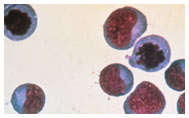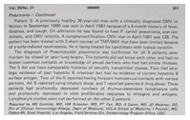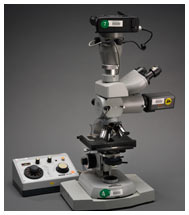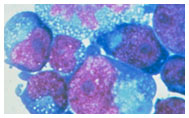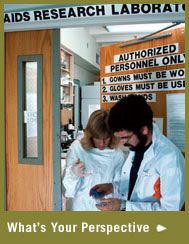ACTION ON AIDS
|
A NEW DISEASE
"It is an indescribable experience knowing that what you are doing will have an impact on the lives… of millions of people." —Anthony Fauci, 1993
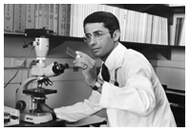 Dr. Anthony Fauci, Director, National Institute of Allergy and Infectious Diseases (NIAID), 1981
Dr. Anthony Fauci, Director, National Institute of Allergy and Infectious Diseases (NIAID), 1981Courtesy National Institute of Allergy and Infectious Diseases
Dr. Anthony Fauci led the NIH response to the epidemic as Director of the National Institute of Allergy and Infectious Diseases (NIAID). Although initially criticized by people living with AIDS and their advocates, he went on to collaborate with members of the AIDS Coalition to Unleash Power(ACT UP)and other activists to plan research and develop drug trials.
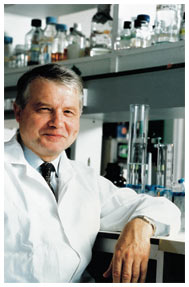 Dr. Luc Montagnier, Pasteur Institute, France, 2000
Dr. Luc Montagnier, Pasteur Institute, France, 2000Reprinted by permission from Macmillan Publishers Ltd: Nature Magazine, Vol. 6, Number 3, March 2000
In May 1983, a team of scientists at the Pasteur Institute in Paris, led by Luc Montagnier, announced that they had isolated a new virus thought to be the cause
of AIDS. The team sent samples of the virus, named LAV, to scientists at the Centers for Disease Control and Prevention (CDC) in Atlanta and the National Institutes of Health (NIH).
The Centers for Disease Control and Prevention (CDC) published an account of a rare lung infection among a group of young gay men in their weekly bulletin for
physicians on June 5, 1981. This article was the first description of a possible new disease. Over the next few months, there were more reports of unusual illnesses later associated with AIDS.
ACT UP was one of many organizations around the world launched to challenge discrimination against people with AIDS,
and to fight for a comprehensive response to the pandemic. On May 21, 1990, ACT UP "stormed the NIH" to protest the slow pace of research and the
limited number of drugs available to treat the disease.
 Dr. Cliff Lane and Dr. Anthony Fauci discussing the first AIDS vaccine trial at the National Institutes of Health, 1987
Dr. Cliff Lane and Dr. Anthony Fauci discussing the first AIDS vaccine trial at the National Institutes of Health, 1987Courtesy National Institute of Allergy and Infectious Diseases
Dr. Anthony Fauci and his colleagues agreed to meet with members of ACT UP to hear their demands. As a direct result of these meetings, the National Institutes of Health (NIH) established policies
to include more women and people of color in clinical trials, to make experimental drugs more widely available, and to give people with HIV a role in planning research. These guidelines are now used in
all medical studies undertaken by the NIH.
 Dr. Lynne Mofenson, National Institute of Child Health and Human Development, 2007
Dr. Lynne Mofenson, National Institute of Child Health and Human Development, 2007Courtesy National Institutes of Health
Pediatrician Lynne Mofenson has led several NIH studies that have shown that antiretroviral drugs can prevent the transmission of HIV from a mother to her child during pregnancy. She also helped
develop clinical guidelines to put this knowledge to use. Every year, these recommendations prevent thousands of new infections among newborns.
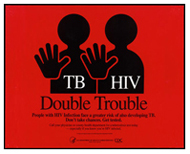 Tuberculosis and HIV health education, Mississippi State Department of Health, 1992
Tuberculosis and HIV health education, Mississippi State Department of Health, 1992Courtesy National Library of Medicine
Although one third of the world's people are infected with tuberculosis (TB), those with healthy immune systems do not develop an active case of the disease.
HIV and AIDS weaken the immune system, making people more vulnerable to active tuberculosis.
TB is the leading cause of death for people who are HIV positive. Although tuberculosis can be treated, multi-drug resistant strains have developed that are
much harder to control. Scientists are researching new drugs to address this problem.
 Dr. Robert C. Gallo, National Cancer Institute, United States, 1980s
Dr. Robert C. Gallo, National Cancer Institute, United States, 1980sCourtesy Courtesy Dewitt Stetten, Jr., Museum of Medical Research, National Institutes of Health
In April 1984, Dr. Robert C. Gallo of the National Cancer Institute at the NIH named a virus he had isolated, HTLV-III, as the cause of AIDS. Scientists later determined that this was the same virus
identified by the Pasteur Institute. The researchers eventually agreed to share credit for the discovery, and in 1986 the virus was renamed Human Immunodeficiency Virus (HIV).
 Human T-Lymphotropic Virus Type III EIA Kit (AIDS test kit), Abbott Laboratories, 1985
Human T-Lymphotropic Virus Type III EIA Kit (AIDS test kit), Abbott Laboratories, 1985Courtesy Dewitt Stetten, Jr., Museum of Medical Research, National Institutes of Health
In January 1985, the Food and Drug Administration (FDA) licensed the first blood test for AIDS. The discovery of the HIV virus had made the development of a test possible, but its use raised ethical
concerns. In the climate of fear surrounding the epidemic it was crucial that HIV positive people be guaranteed confidentiality to protect them from discrimination.
 A local branch of ACT UP from Shreveport, Louisiana, at the National Institutes of Health, 1990
A local branch of ACT UP from Shreveport, Louisiana, at the National Institutes of Health, 1990Courtesy NIH Record
The original ACT UP group from New York inspired numerous other branches nationwide. As well as campaigning in their own states, local groups from across the country attended major rallies.
